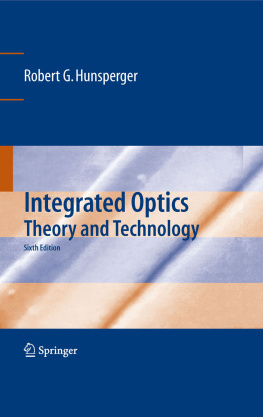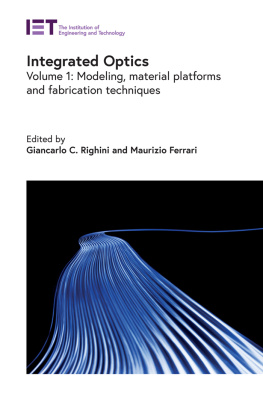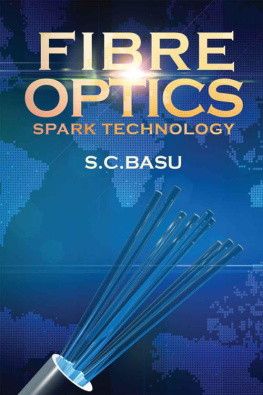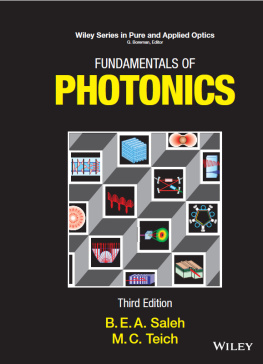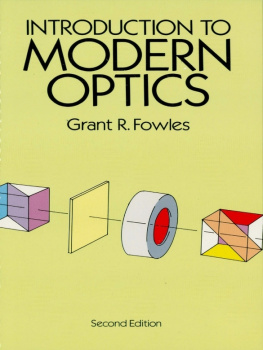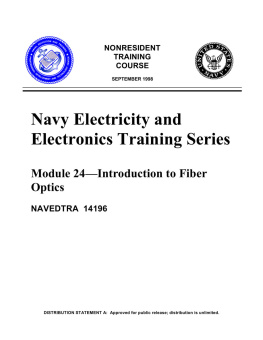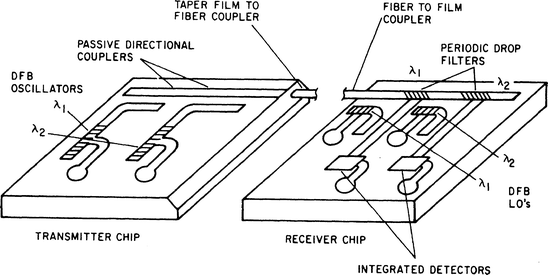1. Introduction
The transmission and processing of signals carried by optical beams rather than by electrical currents or radio waves has been a topic of great interest ever since the early 1960s, when the development of the laser first provided a stable source of coherent light for such applications. Laser beams can be transmitted through the air, but atmospheric variations cause undesirable changes in the optical characteristics of the path from day to day, and even from instant to instant. Laser beams also can be manipulated for signal processing, but that requires optical components such as prisms, lenses, mirrors, electro-optic modulators and detectors. All of this equipment would typically occupy a laboratory bench tens of feet on a side, which must be suspended on a vibration-proof mount. Such a system is tolerable for laboratory experiments, but is not very useful in practical applications.
The transmission and processing of signals carried by optical beams rather than by electrical currents or radio waves has been a topic of great interest ever since the early 1960s, when the development of the laser first provided a stable source of coherent light for such applications. Laser beams can be transmitted through the air, but atmospheric variations cause undesirable changes in the optical characteristics of the path from day to day, and even from instant to instant. Laser beams also can be manipulated for signal processing, but that requires optical components such as prisms, lenses, mirrors, electro-optic modulators and detectors. All of this equipment would typically occupy a laboratory bench tens of feet on a side, which must be suspended on a vibration-proof mount. Such a system is tolerable for laboratory experiments, but is not very useful in practical applications. Thus, in the late 1960s, the concept of integrated optics emerged, in which wires and radio links are replaced by light-waveguiding optical fibers rather than by through-the-air optical paths, and conventional electrical integrated circuits are replaced by miniaturized optical integrated circuits (OICs), also known as photonic integrated circuits (PICs)
For a historical overview of the first years of integrated optics, the reader is referred to the books edited by Tamir []. During the later years of the 1970s, several factors combined to bring integrated optics out of the laboratory and into the realm of practical application; these were the development of low-loss optical fibers and connectors, the creation of reliable cw GaAlAs and GaInAsP laser diodes, and the realization of photolithographic microfabrication techniques capable of submicron linewidths. In the 1980s, optical fibers largely replaced metallic wires in telecommunications, and a number of manufacturers began production of optical integrated circuits for use in a variety of applications. In the 1990s, the incorporation of optical fibers into telecommunications and data-transmission networks has been extended to the subscriber loop in many systems. This provides an enormous bandwidth for multichannel transmission of voice, video and data signals. Access to worldwide communications and data banks has been provided by computer networks such as the Internet. We are in the process of developing what some have called the Information superhighway. The implementation of this technology has provided continuing impetus to the development of new integrated optic devices and systems into the beginning years of the 21st century.
Another technological advance that has encouraged the development of new integrated optic devices in recent years is the availability of improved fabrication methods. Microtechnology, which involves dimensions on the order of micrometers, has evolved into nanotechnology, in which nanometer-sized features are routinely produced. This new area of nanophotonics, which includes the fabrication of photonic crystals, is described in Chapter .
Because of the very broad scope of the field of integrated optics, it is common practice to consider optical fiber waveguides and optical integrated circuits as two separate areas of study, even though they are closely related. For example, the first conference on integrated optics, perse, sponsored by the Optical Society of America, in February 1972 []. Subsequent conferences in this biennial series have included only papers on OICs. In this book, we will concentrate mainly on optical integrated circuits, but we consider first the advantages of a combined fiber-optic OIC system in order to put the subject matter in proper perspective.
The integrated optics approach to signal transmission and processing offers significant advantages in both performance and cost when compared to conventional electrical methods. In this chapter, we consider those advantages in order to generate an understanding of the motivating force behind the development of integrated optics. We also examine the basic question of which substrate materials are most advantageous for the fabrication of OICs, and whether a hybrid or a monolithic approach should be used.
1.1 Advantages of Integrated Optics
To consider the advantages of a fiber-optic OIC system as compared to its electrical counterpart, we show in Fig..
Fig. 1.1
Monolithic integrated optic system for optical communications
1.1.1 Comparison of Optical Fibers with Other Interconnectors
For many years, the standard means of interconnecting electrical subsystems, including integrated circuits, has been either the metallic wire or the radio link through the air. The optical fiber waveguide has many advantages over either of these conventional methods. The most important of these have been listed in Table for easy reference, and they are discussed further below.
Table 1.1
Comparative evaluation of optical interconnectors
Advantages |
Immunity from electromagnetic interference (EMI) |
Freedom from electrical short circuits or ground loops |
Safety in combustible environment |
Security from monitoring |
Low-loss transmission |
Large bandwidth (i.e., multiplexing capability) |
Small size, light weight |
Inexpensive, composed of plentiful materials |
Major disadvantage |
Difficult to use for electrical power transmission |
In modern electronic systems, such as those found in aircraft or in ground based communications systems, it is often necessary to run bundles of wires over considerable distances. These wires can act as receiving antennas, in which extraneous signals are generated by induction from the electromagnetic fields that surround the wire. These fields may be, for example, stray fields from adjacent wires, radio waves in the surrounding environment, or gamma radiation released during a nuclear explosion. In such applications as airborne radar, missile guidance, high-voltage power line fault sensing, and multichannel telecommunications, it is critically important that the system continue to operate normally in the presence of severe electromagnetic interference (EMI). Metallic wires can, of course, be shielded, as in the case of coaxial cables, but the metallic shield adds weight, is costly, and produces parasitic capacitance that limits the frequency response or the bandwidth. The optical fiber waveguide has inherent immunity to most forms of EMI, since there is no metallic wire present in which current can be induced by stray electromagnetic coupling. In addition, it is easy to exclude undesired light waves by covering the fiber (or fiber bundle) with an opaque coating. Cross talk, or interference between the signals carried on adjacent optical fibers in a bundle, is also minimal because each wave-guiding core of the fibers is surrounded by a relatively thick cladding, through which the fields of the guided optical wave cannot penetrate. The immunity that guided optical waves have to EMI is sufficient reason, of itself, to prefer the use of optical fiber interconnectors instead of wires or cables in many applications. However, as we shall see, there are also quite a few other advantages to be gained by their use.

